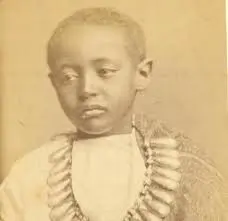Royalty in Africa just like the rest of the world is revered and one of community and sometimes national interest. Members of the royal family represent the communities or nations to which they belong and anything that happens to them is taken as an act for or against the community or nation. Prince Alemayehu, an Ethiopian prince who died in 1875 is the royal piece in today’s article.
In this article, we look at the story of Prince Alemayehu whose story was lived over a century ago between three continents; Africa, Asia and Europe. He was an Ethiopian Prince who became an orphan after his father’s decisions did not work out well as expected. You will learn in this story what decision his father made that resulted in his son moving from Africa to India before heading to the United Kingdom where he died later as a teenager.
Prince Alemayehu was the son of Emperor Tewodros II, the Emperor of Ethiopia from 1855 until his death by suicide in 1868. The reason for his death is what eventually created this story.
In 1962, Emperor Tewodros II sought an alliance with the British and sent out several letters to Queen Victoria. He was doing that in a bid to strengthen his empire. But according to records, the Queen did not respond to the Emperor’s letters and that prompted him to take action.
Emperor Tewodros II was angered by the Queen’s silence so he captured some Europeans including the British Consul and held them. The British were moved to action by that act of the Emperor. Over 13,000 British and Indian military men marched to Maqdala where the Emperor had his fortress. Upon arrival, the Ethiopian troops could not defend against the attack by the British causing a defeat for the Emperor.
Ashamed by his defeat, the Emperor decided to take his own life which he preferred over being a captive in the British hands. The British troops attacked the home of Prince Alemayehu and took the Prince and his mother Empress Tiruwork Wube according to some historical narrations. However, other accounts have it that the Emperor had willed that upon his death his son should go with the British in fear of him becoming a target for the enemies of the Emperor.

The young prince went with his mother and their entourage on the journey to Britain but his mother died on the way from Maqdala to Zula. However, when they got to Alexandria, Captain Speedy who the Empress had earlier resisted his attempt to take custody of the boy took over as the young prince’s caretaker from Sir Robert Napier. Though Napier had allowed the Prince and his chaperones to travel with him Captain Speedy dismissed the entire Ethiopian entourage and went with the boy to Britain.
Prince Alemayehu upon his arrival in Britain stayed with Speedy at the Isle of Wight and was later introduced to Queen Victoria. Queen Victoria was said to have a keen interest in Alemayehu’s life and education and he was sent to the Lockers Park School for his education. He later was sent to study under Thomas Jex-Blake, the Principal of Cheltenham College at Cheltenham and he moved with Thomas Jex-Blake to Rugby School in 1875. The Prince later went to Royal Military College at Sandhurst but grew unhappy there and left for Far Headingley, Leeds, West Yorkshire.
A week after moving to Leeds, he contracted pleuritis and died six weeks later under the care of Dr Clifford Allbutt and other esteemed consultants. He was buried at the catacombs of St George Chapel at Windsor Castle under the directions of Queen Victoria. His body was buried in a brick vault west of the chapel. Prince Alemayehu’s funeral was performed on November 21, 1879, in the presence of his former tutor Cyril Ransome, Chancellor of the Exchequer Stafford Northcote, General Napier, and Captain Speedy. At the nave of St. George’s Chapel is a brass plaque with the inscription “I was a stranger and ye took me in” in commemoration of the Prince. Another plaque commemorating the Prince was arranged by Emperor Haile Selassie to be placed in the chapel.
In 2007, the government of Ethiopia requested that the Prince’s body be brought back to his place of birth for reburial but Buckingham Palace has rejected the request as of May 2023. The reason for the rejection of the request is that exhuming his body would disturb the resting place of other people who have also been buried there.
A Buckingham Palace spokesperson told the BBC in a statement that “It is very unlikely that it would be possible to exhume the remains without disturbing the resting place of a substantial number of others in the vicinity”.
Fasil Minas, a descendant of the royal family told the BBC “It was not right” for the Prince’s body to be buried in Britain. “We want his remains back as a family and as Ethiopians because that is not the country he was born in”.
Discover more from afkmediaonline
Subscribe to get the latest posts sent to your email.




























+ There are no comments
Add yours